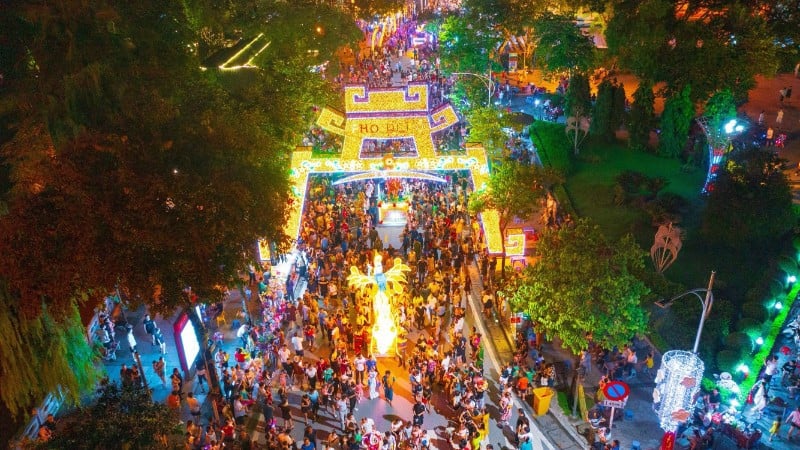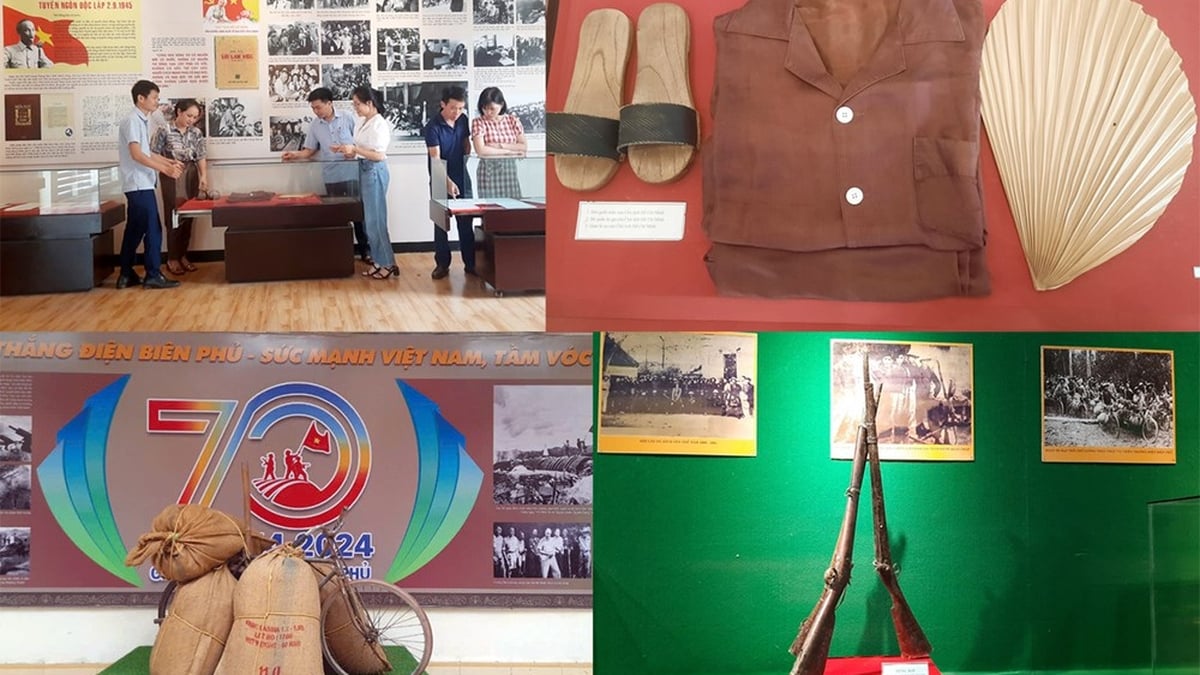
However, in reality, many walking streets are deserted and deserted. This requires the city to review and adjust existing streets before organizing new ones; it is even possible to apply new models to replace them.
Walking streets once brought a “new vitality” to tourism and the night-time economy of Hanoi. However, when the walking streets were expanded, many shortcomings were revealed.
Uneven results
Around 9pm on Saturday is the “golden” time for walking streets, but at Ngoc Ngu Xa walking street (Ba Dinh ward, Hanoi ), many shops and households have closed and turned off the lights. There are some sections of the street with very few people passing by.
The pedestrian space here was originally designed to include two main streets, Ngu Xa-Nguyen Khac Hieu, combined with streets such as Nam Trang, Lac Chinh, Tran Te Xuong... But even in the central area of Ngu Xa-Nguyen Khac Hieu, the business atmosphere is not very vibrant. Only two pho cuon restaurants, Huong Mai and Pho cuon 31, are relatively bustling. Other cafes and eateries are deserted. The street corner where the experience space is arranged, reminiscent of the subsidy period, is dark, with only a few pedestrians passing by occasionally.
The owner of the Tuan Minh pho cuon restaurant (16A Nguyen Khac Hieu Street) said: "There is not much activity on the street so it is quite empty." Some customers quickly left the walking street after eating.
At first, the Ngoc-Ngu Xa walking street was quite bustling, but now it has fallen into a desolate state. Compared to this street, the walking street around Ngoc Khanh lake is even more deserted, although it has been in operation for less than a year. It is introduced as having its own unique features, bearing the mark of "Giang Vo Duong", but in reality, a few decorative highlights depicting martial arts dancers, and some decorative pillars depicting ancient architecture are lost in the walking street.
Since the launch of the activity, cultural, artistic and sports activities to attract the public have been sparse. Previously, Ngoc Khanh Lake was known as “coffee lake” because of the many shops around the lake. But now, on the days of organizing the walking city, there are fewer visitors than usual.
The walking street model in Hanoi was born quite early, more than 20 years ago, with the first street in the Old Quarter, from the beginning of Hang Dao Street to Dong Xuan Market (Hoan Kiem Ward). Currently, the city has 9 walking streets, but the effectiveness is uneven. The spaces: Hoan Kiem Lake and its vicinity; Hanoi Old Quarter (including Hang Dao - Dong Xuan Market route and the future expansion area), Son Tay Citadel (Son Tay Ward) ... are very crowded.
The Tran Nhan Tong walking street and surrounding area (Hai Ba Trung ward) are crowded with visitors when there are cultural, sports and art events, but on weeks when there are no events, they are deserted and are mainly used as exercise places for people around the area. Nguyen Van Tuyet walking street also quickly fell into a state of silence despite being newly opened in October 2024. Trinh Cong Son walking street has stopped operating and converted into the Tay Ho Cultural and Creative Space model.
Create features, enhance experiences
Developing walking spaces is the right policy to develop tourism and night-time economy. Many walking spaces have contributed positively to the socio-economic development of the locality, most notably the spaces in Hoan Kiem ward. However, while Hoan Kiem ward has many advantages due to being the "center of the center", the Son Tay Ancient Citadel walking street is evidence of creativity in activities. Located quite far from the city center, over the years, the walking space around Son Tay Ancient Citadel has never lost its appeal.
According to Nguyen Dang Thao, Director of the Culture and Sports Center of Son Tay Ward, the walking street around Son Tay Citadel attracts an average of 10,000 visitors each night, not only local visitors but also tourists from the city and other provinces. Meanwhile, the main reason for the lack of visitors in the walking spaces is the lack of identity and entertainment, cultural and artistic activities to attract the public.
According to the Tourism Development Plan, in just the next 5 years, Hanoi will double the number of walking streets, up to 18. This September, the walking street around Hoang Cau Lake is expected to be put into operation; following that, Nam Tu Liem district will deploy walking space on Tran Van Lai street. This makes many people worry that Hanoi will "inflation" walking space. Walking spaces themselves compete with each other.
Architect Tran Huy Anh, Standing Member of the Hanoi Architects Association, said that the important thing for Hanoi is not to rapidly increase the number of walking streets, but the core factor is the quality of spatial connections and the value creation of those streets.
According to architect Doan Ky Thanh, people come to walking streets not only to eat and sightsee, but also to communicate. To become a walking space, there must be space for people to stop, for example, the Hoan Kiem Lake area has the Ly Thai To monument and Dong Kinh Nghia Thuc square. These spaces create spaces for social communication. Successful walking spaces must also include commercial elements, when households in the area participate in commercial activities.
Director of Hanoi Department of Tourism Dang Huong Giang said: “In the coming time, the Department of Tourism will coordinate with relevant departments and localities to propose specific criteria for the city to develop the new walking street. It is necessary to focus on some important criteria such as: Location, infrastructure, tourism services of the walking street; the ability to connect the walking street with tourist destinations to create complete tours; the value of natural cultural resources of the walking street and assess the impact of the walking street on the community”.
In early July 2025, the Hanoi People's Council passed a Resolution on the Commercial and Cultural Development Zone and the Cultural Industrial Center. In particular, the Commercial and Cultural Development Zone is a model suitable for craft villages, craft streets, or streets with existing cultural potential, with a high density of establishments participating in cultural activities. From that foundation, the Resolution clearly states that with the support of the State, the residential community, and the business community, it will be built into a Commercial and Cultural Development Zone.
Many experts believe that instead of developing many walking street models, the city as well as localities need to urgently research to make choices and apply new models, especially the Commercial and Cultural Development Zone model to avoid repeating the shortcomings of some walking streets as they are today.
Source: https://nhandan.vn/tang-suc-hut-cho-du-lich-va-kinh-te-dem-post897582.html







































































































Comment (0)